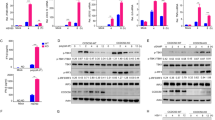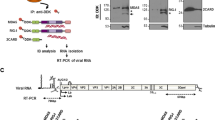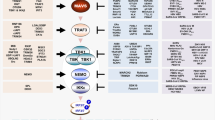Abstract
The concept that viral sensing systems, via their ability to drive pro-inflammatory cytokine and interferon production, contribute to the development of autoimmune and autoinflammatory disease is supported by a wide range of clinical and experimental observations. Recently, the tripartite motif-containing proteins (TRIMs) have emerged as having key roles in antiviral immunity — either as viral restriction factors or as regulators of pathways downstream of viral RNA and DNA sensors, and the inflammasome. Given their involvement in these pathways, we propose that TRIM proteins contribute to the development and pathology of autoimmune and autoinflammatory conditions, thus making them potential novel targets for therapeutic manipulation.
This is a preview of subscription content, access via your institution
Access options
Subscribe to this journal
Receive 12 print issues and online access
$209.00 per year
only $17.42 per issue
Buy this article
- Purchase on Springer Link
- Instant access to full article PDF
Prices may be subject to local taxes which are calculated during checkout


Similar content being viewed by others
References
Ozato, K., Shin, D. M., Chang, T. H. & Morse, H. C. TRIM family proteins and their emerging roles in innate immunity. Nature Rev. Immunol. 8, 849–860 (2008).
Stremlau, M. et al. The cytoplasmic body component TRIM5α restricts HIV-1 infection in Old World monkeys. Nature 427, 848–853 (2004).
Gao, B., Duan, Z., Xu, W. & Xiong, S. Tripartite motif-containing 22 inhibits the activity of hepatitis B virus core promoter, which is dependent on nuclear-located RING domain. Hepatology 50, 424–433 (2009).
Rowe, H. M. et al. KAP1 controls endogenous retroviruses in embryonic stem cells. Nature 463, 237–240 (2010).
McNab, F. W., Rajsbaum, R., Stoye, J. P. & O'Garra, A. Tripartite-motif proteins and innate immune regulation. Curr. Opin. Immunol. 23, 46–56 (2011).
Koffler, D., Carr, R., Agnello, V., Thoburn, R. & Kunkel, H. G. Antibodies to polynucleotides in human sera: antigenic specificity and relation to disease. J. Exp. Med. 134, 294–312 (1971).
Martinon, F., Petrilli, V., Mayor, A., Tardivel, A. & Tschopp, J. Gout-associated uric acid crystals activate the NALP3 inflammasome. Nature 440, 237–241 (2006).
Masters, S. L. et al. Activation of the NLRP3 inflammasome by islet amyloid polypeptide provides a mechanism for enhanced IL-1β in type 2 diabetes. Nature Immunol. 11, 897–904 (2010).
Rehaume, L. M., Jouault, T. & Chamaillard, M. Lessons from the inflammasome: a molecular sentry linking Candida and Crohn's disease. Trends Immunol. 31, 171–175 (2010).
Schroder, K., Zhou, R. & Tschopp, J. The NLRP3 inflammasome: a sensor for metabolic danger? Science 327, 296–300 (2010).
Banchereau, J. & Pascual, V. Type I interferon in systemic lupus erythematosus and other autoimmune diseases. Immunity 25, 383–392 (2006).
Gilliet, M., Cao, W. & Liu, Y. J. Plasmacytoid dendritic cells: sensing nucleic acids in viral infection and autoimmune diseases. Nature Rev. Immunol. 8, 594–606 (2008).
Kyogoku, C. & Tsuchiya, N. A compass that points to lupus: genetic studies on type I interferon pathway. Genes Immun. 8, 445–455 (2007).
Barbalat, R., Ewald, S. E., Mouchess, M. L. & Barton, G. M. Nucleic acid recognition by the innate immune system. Annu. Rev. Immunol. 29, 185–214 (2011).
Lau, C. M. et al. RNA-associated autoantigens activate B cells by combined B cell antigen receptor/Toll-like receptor 7 engagement. J. Exp. Med. 202, 1171–1177 (2005).
Leadbetter, E. A. et al. Chromatin–IgG complexes activate B cells by dual engagement of IgM and Toll-like receptors. Nature 416, 603–607 (2002).
Laragione, T., Brenner, M., Li, W. & Gulko, P. S. Cia5d regulates a new fibroblast-like synoviocyte invasion-associated gene expression signature. Arthritis Res. Ther. 10, R92 (2008).
Oke, V. et al. High Ro52 expression in spontaneous and UV-induced cutaneous inflammation. J. Invest. Dermatol. 129, 2000–2010 (2009).
Carthagena, L. et al. Human TRIM gene expression in response to interferons. PLoS ONE 4, e4894 (2009).
Rajsbaum, R., Stoye, J. P. & O'Garra, A. Type I interferon-dependent and -independent expression of tripartite motif proteins in immune cells. Eur. J. Immunol. 38, 619–630 (2008).
Scofield, R. H., Farris, A. D., Horsfall, A. C. & Harley, J. B. Fine specificity of the autoimmune response to the Ro/SSA and La/SSB ribonucleoproteins. Arthritis Rheum. 42, 199–209 (1999).
Kong, H. J. et al. Cutting edge: autoantigen Ro52 is an interferon inducible E3 ligase that ubiquitinates IRF-8 and enhances cytokine expression in macrophages. J. Immunol. 179, 26–30 (2007).
Higgs, R. et al. The E3 ubiquitin ligase Ro52 negatively regulates IFN-β production post-pathogen recognition by polyubiquitin-mediated degradation of IRF3. J. Immunol. 181, 1780–1786 (2008).
Yang, K. et al. TRIM21 is essential to sustain IFN regulatory factor 3 activation during antiviral response. J. Immunol. 182, 3782–3792 (2009).
Young, J. A. et al. Fas-associated death domain (FADD) and the E3 ubiquitin-protein ligase TRIM21 interact to negatively regulate virus-induced interferon production. J. Biol. Chem. 286, 6521–6531 (2011).
Espinosa, A. et al. Loss of the lupus autoantigen Ro52/Trim21 induces tissue inflammation and systemic autoimmunity by disregulating the IL-23–Th17 pathway. J. Exp. Med. 206, 1661–1671 (2009).
Yoshimi, R. et al. Gene disruption study reveals a nonredundant role for TRIM21/Ro52 in NF-κB-dependent cytokine expression in fibroblasts. J. Immunol. 182, 7527–7538 (2009).
Higgs, R. et al. Self protection from anti-viral responses — Ro52 promotes degradation of the transcription factor IRF7 downstream of the viral Toll-like receptors. PLoS ONE 5, e11776 (2010).
Ozato, K. et al. Comment on “Gene disruption study reveals a nonredundant role for TRIM21/Ro52 in NF-κB-dependent cytokine expression in fibroblasts”. J. Immunol. 183, 7619 (2009).
Espinosa, A., Brauner, S., Ambrosi, A., Kuchroo, V. K. & Wahren-Herlenius, M. Response to comment on “Gene disruption study reveals a nonredundant role for TRIM21/Ro52 in NF-κB-dependent cytokine expression in fibroblasts”. J. Immunol. 183, 7620–7621 (2009).
Mallery, D. L. et al. Antibodies mediate intracellular immunity through tripartite motif-containing 21 (TRIM21). Proc. Natl Acad. Sci. USA 107, 19985–19990 (2010).
Beer, H. D. et al. The estrogen-responsive B box protein: a novel regulator of keratinocyte differentiation. J. Biol. Chem. 277, 20740–20749 (2002).
Cheung, B. B. et al. The estrogen-responsive B box protein is a novel regulator of the retinoid signal. J. Biol. Chem. 281, 18246–18256 (2006).
Marshall, G. M. et al. TRIM16 acts as a tumour suppressor by inhibitory effects on cytoplasmic vimentin and nuclear E2F1 in neuroblastoma cells. Oncogene 29, 6172–6183 (2010).
Vossenaar, E. R. et al. Rheumatoid arthritis specific anti-Sa antibodies target citrullinated vimentin. Arthritis Res. Ther. 6, R142–R150 (2004).
Van Steendam, K., Tilleman, K. & Deforce, D. The relevance of citrullinated vimentin in the production of antibodies against citrullinated proteins and the pathogenesis of rheumatoid arthritis. Rheumatology 50, 830–837 (2011).
Dejaco, C. et al. Diagnostic value of antibodies against a modified citrullinated vimentin in rheumatoid arthritis. Arthritis Res. Ther. 8, R119 (2006).
Mor-Vaknin, N., Punturieri, A., Sitwala, K. & Markovitz, D. M. Vimentin is secreted by activated macrophages. Nature Cell Biol. 5, 59–63 (2003).
Kivity, S., Agmon-Levin, N., Blank, M. & Shoenfeld, Y. Infections and autoimmunity — friends or foes? Trends Immunol. 30, 409–414 (2009).
Uchil, P. D., Quinlan, B. D., Chan, W. T., Luna, J. M. & Mothes, W. TRIM E3 ligases interfere with early and late stages of the retroviral life cycle. PLoS Pathog. 4, e16 (2008).
Balada, E., Vilardell-Tarres, M. & Ordi-Ros, J. Implication of human endogenous retroviruses in the development of autoimmune diseases. Int. Rev. Immunol. 29, 351–370 (2010).
Baudino, L., Yoshinobu, K., Dunand-Sauthier, I., Evans, L. H. & Izui, S. TLR-mediated up-regulation of serum retroviral gp70 is controlled by the Sgp loci of lupus-prone mice. J. Autoimmun. 35, 153–159 (2010).
Baudino, L., Yoshinobu, K., Morito, N., Santiago-Raber, M. L. & Izui, S. Role of endogenous retroviruses in murine SLE. Autoimmun. Rev. 10, 27–34 (2010).
Song, B. TRIM5α. Curr. Top. Microbiol. Immunol. 339, 47–66 (2009).
Sebastian, S. & Luban, J. TRIM5α selectively binds a restriction-sensitive retroviral capsid. Retrovirology 2, 40 (2005).
Nexo, B. A. et al. The etiology of multiple sclerosis: genetic evidence for the involvement of the human endogenous retrovirus HERV-Fc1. PLoS ONE 6, e16652 (2011).
Wolf, D. & Goff, S. P. TRIM28 mediates primer binding site-targeted silencing of murine leukemia virus in embryonic cells. Cell 131, 46–57 (2007).
Wolf, D. & Goff, S. P. Embryonic stem cells use ZFP809 to silence retroviral DNAs. Nature 458, 1201–1204 (2009).
Gack, M. U. et al. TRIM25 RING-finger E3 ubiquitin ligase is essential for RIG-I-mediated antiviral activity. Nature 446, 916–920 (2007).
Zeng, W. et al. Reconstitution of the RIG-I pathway reveals a signaling role of unanchored polyubiquitin chains in innate immunity. Cell 141, 315–330 (2010).
Wang, P. et al. Caspase-12 controls West Nile virus infection via the viral RNA receptor RIG-I. Nature Immunol. 11, 912–919 (2010).
Tsuchida, T. et al. The ubiquitin ligase TRIM56 regulates innate immune responses to intracellular double-stranded DNA. Immunity 33, 765–776 (2010).
Zha, J. et al. The Ret finger protein inhibits signaling mediated by the noncanonical and canonical IκB kinase family members. J. Immunol. 176, 1072–1080 (2006).
Baranzini, S. E. The genetics of autoimmune diseases: a networked perspective. Curr. Opin. Immunol. 21, 596–605 (2009).
Noguchi, K. et al. TRIM40 promotes neddylation of IKKγ and is downregulated in gastrointestinal cancers. Carcinogenesis 32, 995–1004 (2011).
Arimoto, K. et al. Polyubiquitin conjugation to NEMO by triparite motif protein 23 (TRIM23) is critical in antiviral defense. Proc. Natl Acad. Sci. USA 107, 15856–15861 (2010).
Poole, E. et al. Identification of TRIM23 as a cofactor involved in the regulation of NF-κB by human cytomegalovirus. J. Virol. 83, 3581–3590 (2009).
Nishibori, T., Tanabe, Y., Su, L. & David, M. Impaired development of CD4+ CD25+ regulatory T cells in the absence of STAT1: increased susceptibility to autoimmune disease. J. Exp. Med. 199, 25–34 (2004).
Bettelli, E. et al. Loss of T-bet, but not STAT1, prevents the development of experimental autoimmune encephalomyelitis. J. Exp. Med. 200, 79–87 (2004).
Sigurdsson, S. et al. Polymorphisms in the tyrosine kinase 2 and interferon regulatory factor 5 genes are associated with systemic lupus erythematosus. Am. J. Hum. Genet. 76, 528–537 (2005).
Graham, R. R. et al. A common haplotype of interferon regulatory factor 5 (IRF5) regulates splicing and expression and is associated with increased risk of systemic lupus erythematosus. Nature Genet. 38, 550–555 (2006).
Salloum, R. et al. Genetic variation at the IRF7/PHRF1 locus is associated with autoantibody profile and serum interferon-α activity in lupus patients. Arthritis Rheum. 62, 553–561 (2010).
Feng, D. et al. Genetic variants and disease-associated factors contribute to enhanced interferon regulatory factor 5 expression in blood cells of patients with systemic lupus erythematosus. Arthritis Rheum. 62, 562–573 (2010).
Kamitani, S. et al. KAP1 regulates type I interferon/STAT1-mediated IRF-1 gene expression. Biochem. Biophys. Res. Commun. 370, 366–370 (2008).
Tsuruma, R. et al. Physical and functional interactions between STAT3 and KAP1. Oncogene 27, 3054–3059 (2008).
Wada, K., Niida, M., Tanaka, M. & Kamitani, T. Ro52-mediated monoubiquitination of IKKβ down-regulates NF-κB signalling. J. Biochem. 146, 821–832 (2009).
Niida, M., Tanaka, M. & Kamitani, T. Downregulation of active IKKβ by Ro52-mediated autophagy. Mol. Immunol. 47, 2378–2387 (2010).
Everett, R. D. & Chelbi-Alix, M. K. PML and PML nuclear bodies: implications in antiviral defence. Biochimie 89, 819–830 (2007).
El Bougrini, J., Dianoux, L. & Chelbi-Alix, M. K. PML positively regulates interferon γ signaling. Biochimie 93, 389–398 (2011).
Wu, W. S., Xu, Z. X. & Chang, K. S. The promyelocytic leukemia protein represses A20-mediated transcription. J. Biol. Chem. 277, 31734–31739 (2002).
Wu, W. S. et al. Promyelocytic leukemia protein sensitizes tumor necrosis factor α-induced apoptosis by inhibiting the NF-κB survival pathway. J. Biol. Chem. 278, 12294–12304 (2003).
Xu, D. et al. Promyelocytic leukemia zinc finger protein regulates interferon-mediated innate immunity. Immunity 30, 802–816 (2009).
Stinton, L. M., Swain, M., Myers, R. P., Shaheen, A. A. & Fritzler, M. J. Autoantibodies to GW bodies and other autoantigens in primary biliary cirrhosis. Clin. Exp. Immunol. 163, 147–156 (2011).
Fracchia, M. et al. Serum interferon γ in primary biliary cirrhosis: effect of ursodeoxycholic acid and prednisone therapy alone and in combination. Eur. J. Gastroenterol. Hepatol. 12, 463–468 (2000).
Okumura, F., Matsunaga, Y., Katayama, Y., Nakayama, K. I. & Hatakeyama, S. TRIM8 modulates STAT3 activity through negative regulation of PIAS3. J. Cell Sci. 123, 2238–2245 (2010).
Okumura, F., Okumura, A. J., Matsumoto, M., Nakayama, K. I. & Hatakeyama, S. TRIM8 regulates Nanog via Hsp90β-medicated nuclear translocation of STAT3 in embryonic stem cells. Biochim. Biophys. Acta 2 Jun 2011 (doi:10.1016/j.bbamcr.2011.05.013).
Ben-Zvi, I. & Livneh, A. Chronic inflammation in FMF: markers, risk factors, outcomes and therapy. Nature Rev. Rheumatol. 7, 105–112 (2011).
Shaw, P. J., McDermott, M. F. & Kanneganti, T. D. Inflammasomes and autoimmunity. Trends Mol. Med. 17, 57–64 (2011).
Richards, N. et al. Interaction between pyrin and the apoptotic speck protein (ASC) modulates ASC-induced apoptosis. J. Biol. Chem. 276, 39320–39329 (2001).
Yu, J. W. et al. Pyrin activates the ASC pyroptosome in response to engagement by autoinflammatory PSTPIP1 mutants. Mol. Cell 28, 214–227 (2007).
Papin, S. et al. The SPRY domain of Pyrin, mutated in familial Mediterranean fever patients, interacts with inflammasome components and inhibits proIL-1β processing. Cell Death Differ. 14, 1457–1466 (2007).
Yu, J. W. et al. Cryopyrin and pyrin activate caspase-1, but not NF-κB, via ASC oligomerization. Cell Death Differ. 13, 236–249 (2006).
Chae, J. J. et al. The familial Mediterranean fever protein, pyrin, is cleaved by caspase-1 and activates NF-κB through its N-terminal fragment. Blood 112, 1794–1803 (2008).
Chae, J. J. et al. The B30.2 domain of pyrin, the familial Mediterranean fever protein, interacts directly with caspase-1 to modulate IL-1β production. Proc. Natl Acad. Sci. USA 103, 9982–9987 (2006).
Unal, A., Dursun, A., Emre, U., Tascilar, N. F. & Ankarali, H. Evaluation of common mutations in the Mediterranean fever gene in multiple sclerosis patients: is it a susceptibility gene? J. Neurol. Sci. 294, 38–42 (2010).
Yahalom, G. et al. Familial Mediterranean fever (FMF) and multiple sclerosis: an association study in one of the world's largest FMF cohorts. Eur. J. Neurol. 8 Feb 2011 (doi:10.1111/j.1468-1331.2011.0 3356.x).
Merrill, J. E. Proinflammatory and antiinflammatory cytokines in multiple sclerosis and central nervous system acquired immunodeficiency syndrome. J. Immunother. 12, 167–170 (1992).
Shoham, N. G. et al. Pyrin binds the PSTPIP1/CD2BP1 protein, defining familial Mediterranean fever and PAPA syndrome as disorders in the same pathway. Proc. Natl Acad. Sci. USA 100, 13501–13506 (2003).
Munding, C. et al. The estrogen-responsive B box protein: a novel enhancer of interleukin-1β secretion. Cell Death Differ. 13, 1938–1949 (2006).
Hu, Y. et al. Tripartite-motif protein 30 negatively regulates NLRP3 inflammasome activation by modulating reactive oxygen species production. J. Immunol. 185, 7699–7705 (2010).
Zhou, R., Yazdi, A. S., Menu, P. & Tschopp, J. A role for mitochondria in NLRP3 inflammasome activation. Nature 469, 221–225 (2011).
Shi, M. et al. TRIM30α negatively regulates TLR-mediated NF-κB activation by targeting TAB2 and TAB3 for degradation. Nature Immunol. 9, 369–377 (2008).
Tareen, S. U. & Emerman, M. Human Trim5α has additional activities that are uncoupled from retroviral capsid recognition. Virology 409, 113–120 (2011).
Pertel, T. et al. TRIM5 is an innate immune sensor for the retrovirus capsid lattice. Nature 472, 361–365 (2011).
Reymond, A. et al. The tripartite motif family identifies cell compartments. EMBO J. 20, 2140–2151 (2001).
Asaoka, K. et al. A retrovirus restriction factor TRIM5α is transcriptionally regulated by interferons. Biochem. Biophys. Res. Commun. 338, 1950–1956 (2005).
Chelbi-Alix, M. K. et al. Induction of the PML protein by interferons in normal and APL cells. Leukemia 9, 2027–2033 (1995).
Strandberg, L. et al. Interferon-α induces up-regulation and nuclear translocation of the Ro52 autoantigen as detected by a panel of novel Ro52-specific monoclonal antibodies. J. Clin. Immunol. 28, 220–231 (2008).
Casciola-Rosen, L. A., Anhalt, G. & Rosen, A. Autoantigens targeted in systemic lupus erythematosus are clustered in two populations of surface structures on apoptotic keratinocytes. J. Exp. Med. 179, 1317–1330 (1994).
Ohlsson, M., Jonsson, R. & Brokstad, K. A. Subcellular redistribution and surface exposure of the Ro52, Ro60 and La48 autoantigens during apoptosis in human ductal epithelial cells: a possible mechanism in the pathogenesis of Sjogren's syndrome. Scand. J. Immunol. 56, 456–469 (2002).
Chae, J. J. et al. Targeted disruption of pyrin, the FMF protein, causes heightened sensitivity to endotoxin and a defect in macrophage apoptosis. Mol. Cell 11, 591–604 (2003).
Hoshino, K. et al. Anti-MDA5 and anti-TIF1-γ antibodies have clinical significance for patients with dermatomyositis. Rheumatology 49, 726–1733 (2010).
Randrianarison-Huetz, V. et al. Gfi-1B controls human erythroid and megakaryocytic differentiation by regulating TGF-β signaling at the bipotent erythro-megakaryocytic progenitor stage. Blood 115, 2784–2795 (2010).
Billaut-Mulot, O. et al. SS-56, a novel cellular target of autoantibody responses in Sjogren syndrome and systemic lupus erythematosus. J. Clin. Invest. 108, 861–869 (2001).
Acknowledgements
The authors would like to acknowledge Science Foundation Ireland (grants 05/PICA/B815 and 08/IN.1/B2091) and the Health Research Board, Ireland (grant PHD/2007/11) for financial support associated with this work.
Author information
Authors and Affiliations
Corresponding author
Ethics declarations
Competing interests
The authors declare no competing financial interests.
Supplementary information
Supplementary Figure 1
TRIM structure and genomic clusters. (PDF 253 kb)
Supplementary Figure 2
TRIM family and domain structures. (PDF 323 kb)
Related links
Rights and permissions
About this article
Cite this article
Jefferies, C., Wynne, C. & Higgs, R. Antiviral TRIMs: friend or foe in autoimmune and autoinflammatory disease?. Nat Rev Immunol 11, 617–625 (2011). https://doi.org/10.1038/nri3043
Published:
Issue Date:
DOI: https://doi.org/10.1038/nri3043
This article is cited by
-
RNA-binding activity of TRIM25 is mediated by its PRY/SPRY domain and is required for ubiquitination
BMC Biology (2017)
-
Relationship of TRIM5 and TRIM22 polymorphisms with liver disease and HCV clearance after antiviral therapy in HIV/HCV coinfected patients
Journal of Translational Medicine (2016)
-
Two Genetic Variations in the IRF8 region are associated with Behçet’s disease in Han Chinese
Scientific Reports (2016)
-
TRIM52 inhibits Japanese Encephalitis Virus replication by degrading the viral NS2A
Scientific Reports (2016)
-
Trim44 facilitates the migration and invasion of human lung cancer cells via the NF-κB signaling pathway
International Journal of Clinical Oncology (2015)



